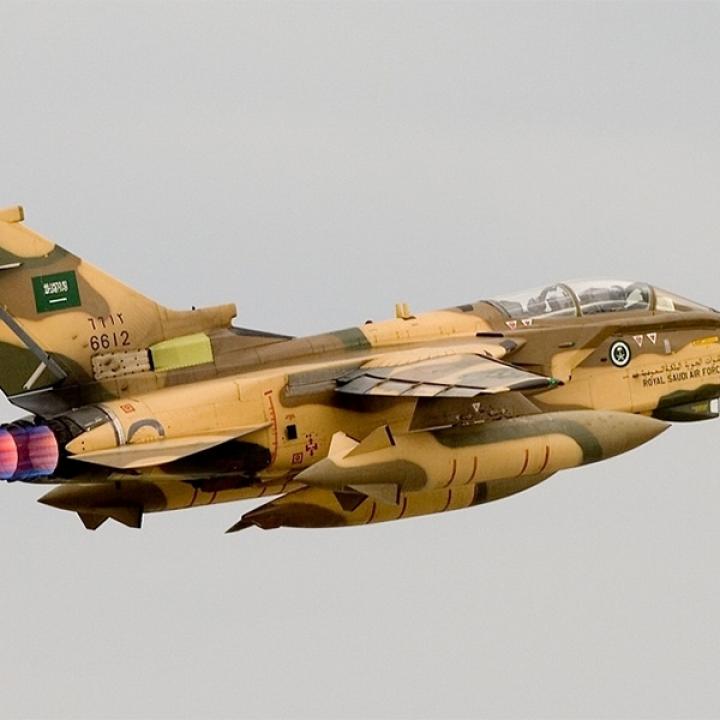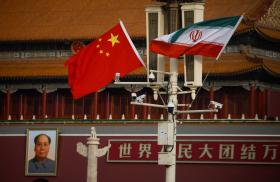
- Policy Analysis
- PolicyWatch 2393
Assisting the Arab Military Intervention in Yemen

Washington can play a valuable behind-the-scenes role in Operation Decisive Storm, maximizing the chance that U.S. allies can prevent a Houthi takeover.
On March 26, Saudi Arabia announced the beginning of Operation Decisive Storm, the pan-Arab military operation to halt the advance of Yemen's Houthi militia, Ansar Allah. Riyadh has been preparing an operation of this kind ever since its short but bloody war against the Houthis five years ago, but the mobilization of nine other Muslim-majority nations points to the campaign's broader strategic purpose -- creating an Arab rallying point against rising Iranian military activism in the region. The United Arab Emirates, Egypt, Pakistan, Jordan, Bahrain, Kuwait, Qatar, Morocco, and Sudan have all pledged forces to the operation.
Washington now finds itself in a novel situation, supporting a major multinational coalition of regional states from the sidelines, precisely the kind of burden-sharing that successive U.S. governments have dreamed of fostering. To ensure the best outcome, however, it will need to plan its operational and diplomatic involvement carefully.
BACKDROP TO INTERVENTION
The Houthi tribes of northern Yemen follow the Zaidi branch of Islam, which adheres to a different political theology than Twelver Shiism, Iran's state religion. Yet they venerate many of the same Shiite religious figures as Twelvers, among numerous other religious and political affinities with Tehran (for more on these affinities, see "Yemen's Zaidis: A Window for Iranian Influence," PolicyWatch 2364). Perhaps most important, the Houthis have been driven toward Iran by a decade of fighting Yemen's central government and al-Qaeda-leaning Salafist militias, both backed by Saudi Arabia. In 2009-2010, the Saudis fought a painful border war against the Houthis, suffering 114 fatalities. Since then, Riyadh's historical allies in Yemen -- the Hashid tribal confederation, who practice the Shafi'i branch of Sunni Islam, along with related Salafist groups -- have feuded, opening up space for the Houthis to overrun the capital and impose their demands on the internationally recognized government of President Abdu Rabu Mansour Hadi.
Recent months have witnessed a cascading collapse of Mansour Hadi's authority. In February, he fled Sana to an alternate base in Aden, the country's second-largest city located in the deep south. Thereafter, the Houthis and their allies within the Hashid confederation -- military leaders loyal to former president Ali Abdullah Saleh, ousted in 2012 -- began pressuring key southern installations. On March 20, they lunged forward in a series of long-range road and helicopter advances to seize Taizz, Yemen's third-largest city, and to overrun al-Anad Air Base, a joint Yemeni-U.S. counterterrorism facility sixty kilometers north of Aden. By March 25, they were skirmishing for control of Aden's international airport and presidential palace, driving Mansour Hadi to relocate to al-Mukalla port in the east and thence to Saudi Arabia.
PLANNED OPERATIONS
Although the shape and duration of Operation Decisive Storm is not yet known, the coalition is preparing to take steps in the three traditional spheres of modern warfare -- air, sea, and land:
- Airstrikes. In predawn attacks on March 26, Saudi strike aircraft bombed a range of military targets in Sana and the Houthi leadership center of Harf Sufyan in Amran governorate, including the house of Ansar Allah leader Abdul Majid al-Houthi. Strikes continued throughout the day involving Emirati, Jordanian, Kuwaiti, Bahraini, and Qatari air forces. In theory, around 170 modern strike aircraft have been allocated to the effort, including 100 from Saudi Arabia (mostly F-15S and Tornado IDS aircraft), 30 from the UAE (F-16s and Mirage 2000s), and several F-16s from Bahrain (15), Jordan (6), and Morocco (6). If needed, Riyadh could easily commit far larger numbers; Egypt and Pakistan could contribute aircraft as well.
- Naval operations. Cairo and Riyadh have already committed naval and coast guard forces to the operation, with Egyptian craft patrolling the Bab al-Mandab Strait and Saudi vessels extending their preexisting coastal patrols off Yemen to include Red Sea ports used for military resupply by the Houthis. Pakistan may provide naval assets as well. Egypt, Saudi Arabia, and the UAE also have the ability to mount amphibious operations along Yemen's coast, threatening the western flank of the Houthi advance.
- Land operations. Saudi Arabia is mobilizing land forces along its southern border with Yemen, the same terrain over which it fought the Houthis in 2009-2010. In Aden, where pro-government forces are fighting to hold the airport and other key installations, Riyadh, Cairo, and Pakistan also appear to be preparing for the option of landing small expeditionary forces. Other pockets are holding out against Houthi-allied forces in the oil-rich Marib governorate and the natural gas center of Shabwa, though tribal forces in these areas seem to be leaning as much on military support from al-Qaeda in the Arabian Peninsula (AQAP) as from pro-government security forces.
U.S. SUPPORT
The United States is a strong backer of Mansour Hadi, who on March 24 requested military intervention "based on the principle of self-defense in Article 51 of the Charter of the United Nations" as well as "the Charter of the Arab League and the treaty of joint Arab defense." In reality, the United States is an unspoken member of the coalition, operating "a joint planning cell with Saudi Arabia to coordinate U.S. military and intelligence support," in the words of National Security Council spokeswoman Bernadette Meehan.
To some extent, Washington's job is to stay out of its allies' way as they craft their intervention. At the same time, the United States needs to weigh carefully the complexities of the current situation and set triggers for further U.S. involvement on certain issues.
For instance, AQAP will likely use the conflict to slip further into the political-military mainstream, much as some Salafi militant groups have done in Syria since the uprising against Bashar al-Assad began. The "Islamic State"/ISIS is likewise trying to grow in the chaos and vacuum of faltering state authority, as shown by its killing of 137 Houthis in a series of Sana suicide bombings on March 20. And Saudi Arabia remains exceedingly wary of embracing AQAP considering the movement's many attacks on the kingdom. Washington should reinforce Arab caution toward such groups and resist their integration into any anti-Houthi coalition on the ground in Yemen, maintaining as much continuity as possible in the U.S.-led counterterrorism mission.
Furthermore, if Washington wants to let the intervention play out and potentially reverse the military balance in Mansour Hadi's favor, it should use its international influence to provide a protected diplomatic flank for the Arab coalition. For laudable humanitarian reasons that America shares, many nations will seek to shut down the operation before it has achieved its strategic objectives, but the needs of regional allies must also be taken into account. For instance, a no-fly zone -- a solution often favored by international actors -- would probably hurt allies in this case.
On the operational front, Washington's key role should be to provide wise counsel and responsive logistical assistance, including:
- Coordination and planning. Saudi Arabia gained a lot of operational experience in its previous fight with the Houthis, but coalition warfare and joint operations are among the most complex military tasks to undertake. Ongoing U.S. support through the Joint Planning Cell will therefore be vital, particularly if Riyadh opens a front against the Houthis in northern Yemen or if amphibious landings are attempted.
- Intelligence support. The initial set of military targets hit by the March 26 airstrikes were well-reconnoitered, but the real targeting challenge begins now that they have been struck. Air campaigns are only as good as their ongoing targeting intelligence. Facing intense pressure on its overworked intelligence, surveillance, and reconnaissance (ISR) assets due to commitments in Afghanistan and against ISIS, the United States needs to optimize the performance of Arab ISR assets and draw in new coalition partners for behind-the-scenes Western intelligence provision. Washington should pay particular attention to locating medium-range missile systems, aircraft, and helicopters not currently under Yemeni government control.
- Logistical support to smaller allies. Saudi Arabia faces relatively few challenges operating its long-range strike aircraft from its home bases, but other force providers are operating shorter-range aircraft away from their home bases, creating a potential need for U.S. logistical support and the coordination of aerial refueling.
- Training and equipping the Yemeni armed forces. In time, Washington could recommence its role in training and equipping the Yemeni Special Forces plus select intelligence, army, and Interior Ministry units. The Gulf states are likely to try replicating security assistance programs they have undertaken in Lebanon, Libya, and Syria. Matching U.S. experience and professionalism with the deep pockets and large surplus equipment inventories of Gulf nations might greatly accelerate the development of reliable national security forces in Yemen, minimizing the role of tribal militias and AQAP-linked fighters.
Michael Knights is a Boston-based Lafer Fellow with The Washington Institute.



